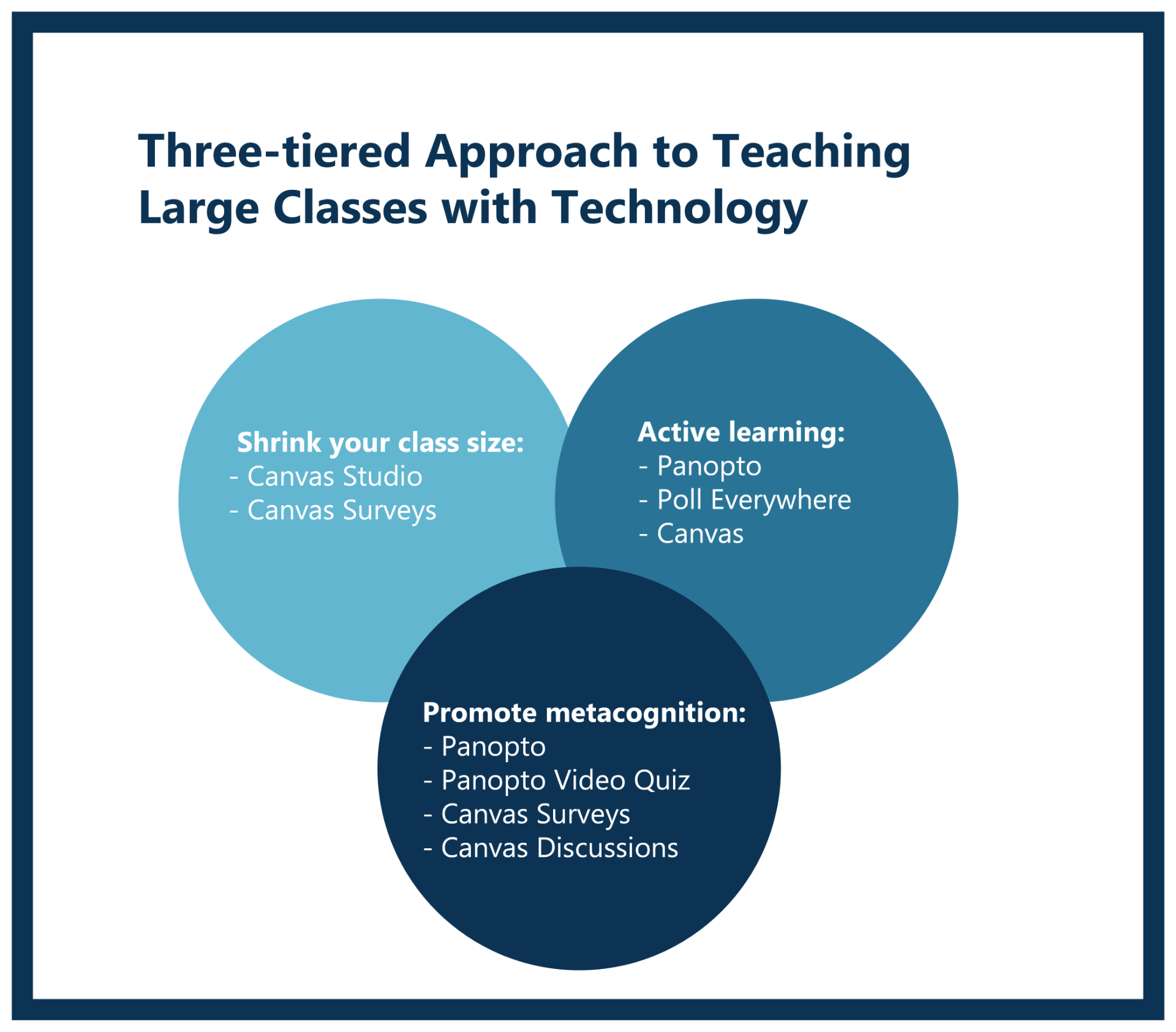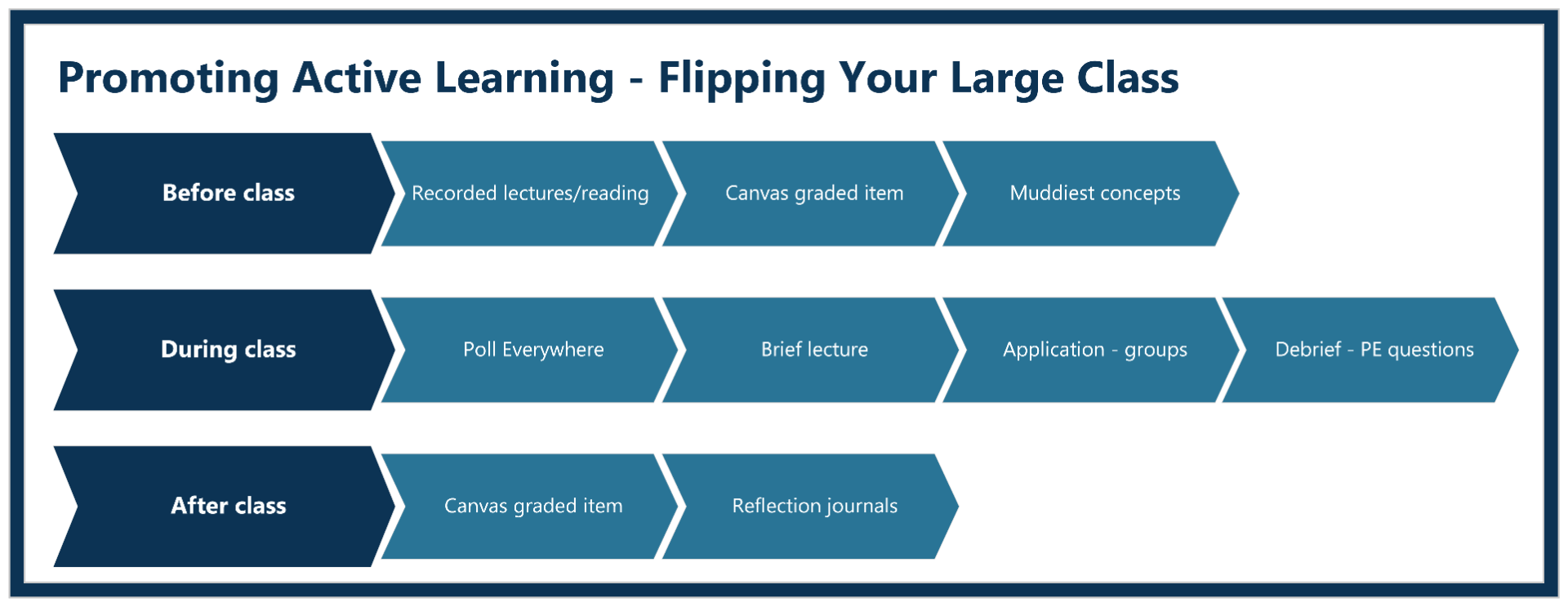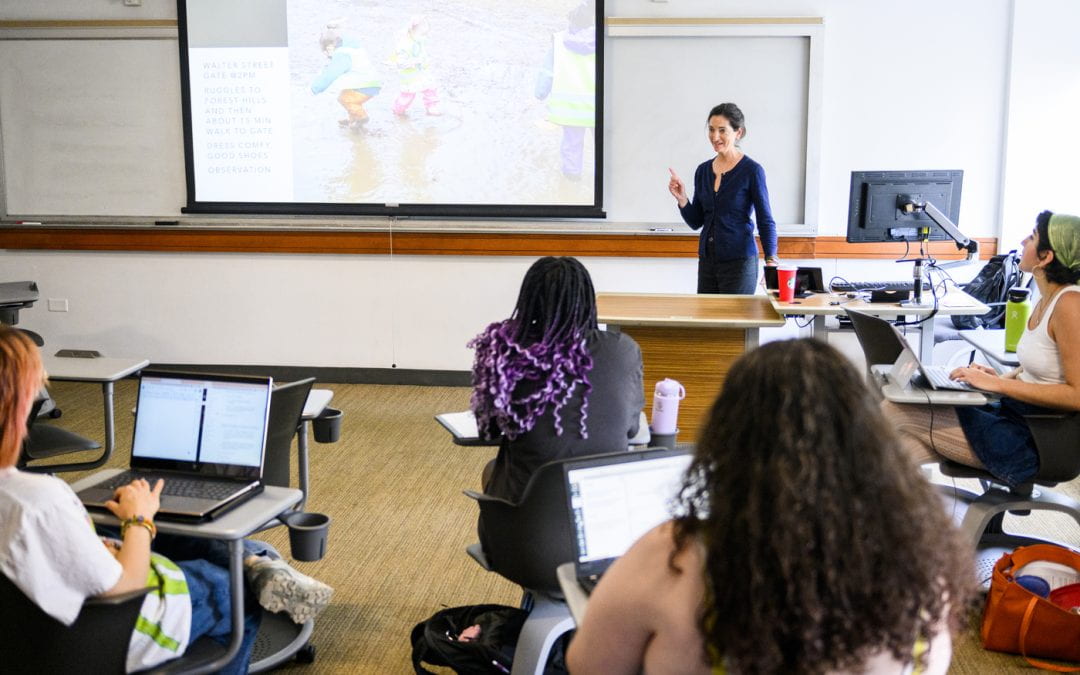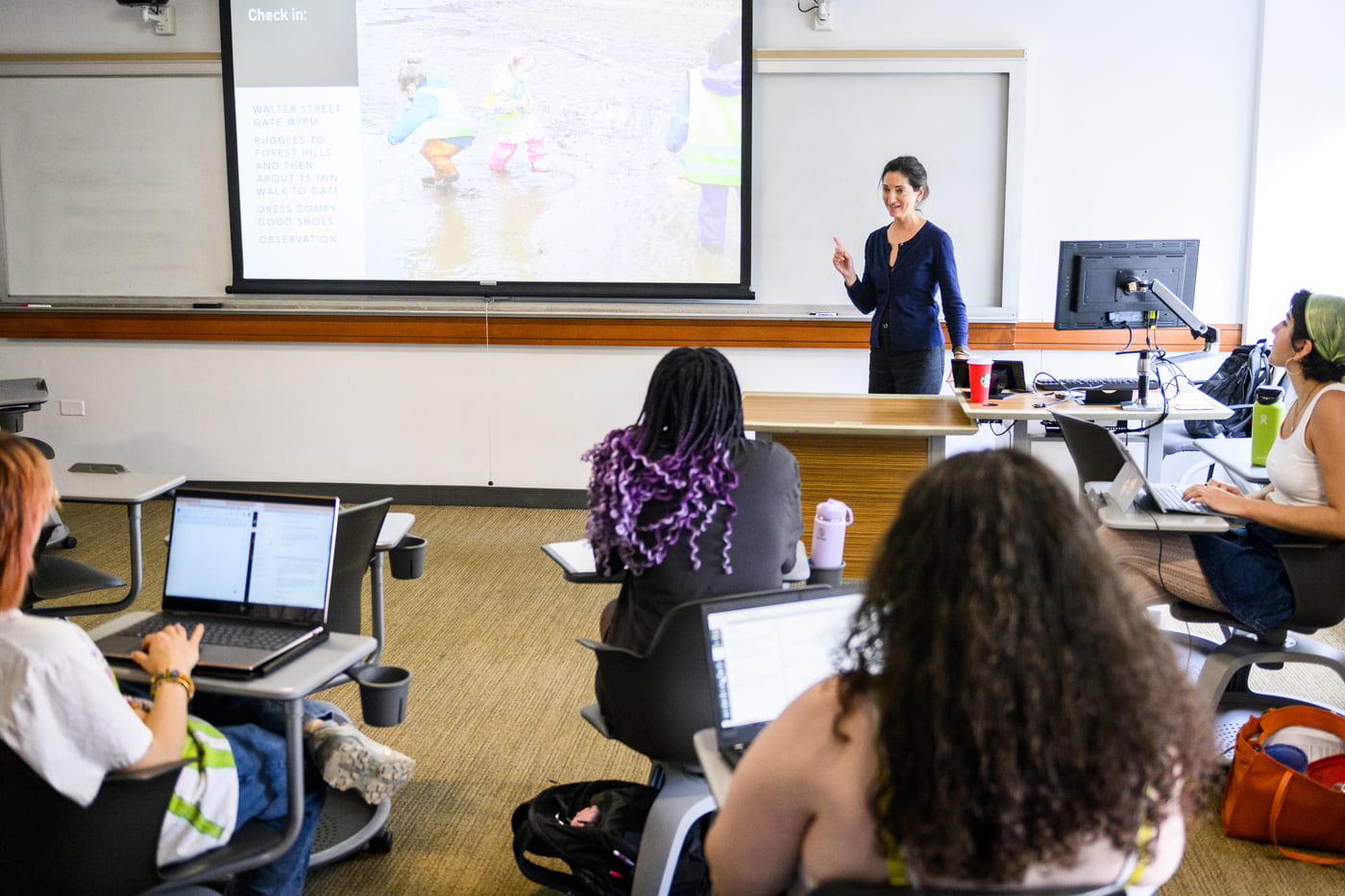Leveraging Canvas and integrated tools, Teaching Professor and Director of Undergraduate Studies for Biology Missy McElligott has developed an inclusive, three-tiered approach to teaching her large introductory biology course that effectively shrinks the class size while promoting metacognition and active learning. This unique approach sparks deeper levels of critical thinking, learning, creativity, and collaborative problem-solving. Each tier has been thoughtfully designed to combat the challenges McElligott faced while teaching large classes.
To ensure the success of her three-tiered approach, McElligott has curated a technical toolbox filled with readily available and easy-to-use tools like Panopto, Poll Everywhere, a social video tool, a digital whiteboard, and a multitude of Canvas features such as Discussions, Studio, surveys, and quiz statistics. While McElligott is very self-reliant, she has participated in Center for Advancing Teaching and Learning Through Research (CATLR) and Academic Technologies collaborative workshops and consults with Academic Technologies to maximize her classroom technology.

Large Class Challenges
Course design and instructional effectiveness can be more challenging in large-enrollment courses, especially in STEM courses. The main challenges that McElligott identified while teaching large classes were:
- Connecting with students to build rapport, target personal interests, identify learning struggles (particularly in first-year courses), promote accountability, and reduce anonymity.
- Building community between students to foster personal connections, promote teamwork, and develop a sense of belonging.
- Handling the logistics for the distribution of materials, grading, exams, and communication.
After identifying these challenges, McElligott created an effective approach to overcoming them, utilizing an abundance of tools that are readily available to instructors at Northeastern.
Shrink the Class Size
Because large classes can feel impersonal, McElligott has developed a way to create connection and engagement to ensure that her students don’t feel lost in the background; McElligott refers to this as “shrinking” the class. McElligott begins shrinking the class by having students complete a video introduction and take a pre-class survey. This is all done within Canvas, establishing Canvas as the home base for learning from the beginning. McElligott then uses information students provide about themselves to break the large class into semester-long small groups of three to four students.
Using a social video tool such as Canvas Studio or Flip, McElligott sets up the course video introduction assignment for students to complete during the first week; McElligott asks that students provide their name, pronouns, their major (and the reason they chose their major), and a hobby. The videos help McElligott to match student names to their faces and promote inclusivity by knowing how to accurately pronounce names or learn if the student has a preferred name or pronoun. Asking the reason for their majors and hobbies helps her further connect with the students and target their personal interests when they stop by her office for what she refers to as “student hours.” If McElligott knows a student will be coming to her office, she takes the time to rewatch their video so she can connect with the student on topics they enjoy and alleviate some of their nervousness, which in turn makes the students feel more open to sharing any struggles they may be having. Because these videos are in Canvas, they’re easily accessible throughout the year for McElligott and her students to refer to throughout the semester.
She has found that using a social video tool is invaluable for both connecting with her students and connecting students with each other. The video introductions come naturally for students in the TikTok generation and allow them to learn about each other once they are placed into their groups.
McElligott also has students complete a pre-class survey during the first week using the Canvas survey tool. The pre-class surveys help McElligott identify the student’s goals, interests, and potential struggles, and also get an overall idea of their background. Students aren’t required to share their struggles, but they’re invited to share any logistical or personal struggles, like purchasing a textbook or an unstable Wi-Fi connection. Many students have additionally chosen to share their more personal struggles with anxiety or depression. Throughout the semester, if McElligott notices that a student is having a difficult time, she can go back to those pre-class surveys in Canvas to see if there might be some background she can draw upon in conversation.
Promote Metacognition
McElligott promotes metacognition in her large classes by including instructor perspective videos and values affirmations in Canvas combined with student reflection surveys in her online textbook. Metacognition, the ability to think about and regulate one’s thinking, is essential to effective student learning. McElligott teaches students in their first semester, so one of her goals is to teach her students new strategies for learning. She recognizes the challenges that many of her students face:
What a lot of students don’t realize is that the strategies for learning that might have worked in high school often don’t work in college, and this is surprising [to them]. Our students are high achievers, and they’re used to some academic success, so I see it as a major component of my course to say, not only am I going to teach you biology, I’m going to teach you how to learn biology because this is a skill that’s going to transfer.
McElligott begins laying a foundation for promoting metacognition on the first day of class by leading a discussion about different learning strategies and presenting the class with data to show which strategies are the most, and least, effective. She continues to build over the semester with checkpoint surveys in either Canvas or her online textbook, which she uses to identify the learning strategies that her students used, how much time they spent preparing, their confidence heading into the exam, and what strategies they’ll use for the next exam. The surveys guide students through a reflective process, allowing them to determine the learning strategies that work best for them.
Another way that McElligott promotes metacognition in her classes is by taking the time to give the students the instructor’s perspective in her pre-class Canvas videos:
I think part of learning is recognizing why we’re learning what we’re learning, why the instructor is teaching what they’re teaching, and trying to make it personal for the students. I tried to include an instructor’s perspective in all the videos, or even in a separate video. I think that speaks to that meta-cognitive aspect where I’m trying to give them an intrinsic reason to want to study, work hard, and really learn for the sake of learning rather than just memorizing some details.
McElligott uses Panopto to create the video. Because Panopto is integrated directly into Canvas, McElligott can quickly record instructor perspectives and embed them directly in pages in the Canvas modules to create a seamless learning experience for students.
Promote Active Learning
Using Canvas as the digital home base, McElligott flips the class by having students review course materials either in Canvas or in the online textbook, prior to coming to class. Students are then prepared to come to class and work with their groups to apply those materials to active learning exercises.
McElligott uses active learning to “move material out of the classroom to provide time and space for the application of concepts, problem-solving, and promoting teamwork” and “allow more time for exploring nuances of material and probing more complicated concepts.” One way that McElligott promotes active learning is by using Panopto to record lectures, posting the lectures on Canvas, and requiring students to watch the lectures before class, allowing class time to be used to focus on difficult concepts and group work. To ensure that students are actually watching the videos, McElligott uses Panopto’s quiz feature to add knowledge check questions to the Panopto recordings, which are then linked to her grade book. She also likes to mix up the pre-class work by assigning an online video or podcast and will ask students to complete a short reflection, post to the Canvas discussion board, or let them know there will be an in-class Poll Everywhere quiz on the material. McElligott finds that assigning pre-class work ensures that the students are “more primed to have a discussion with their peers about the nuances of that material, or the application of that material, or even some of the confusion that they might be having with that material.” If McElligott finds that a significant number of students have had trouble with a particular quiz question, she can address any misconceptions during class time.
McElligott promotes peer collaboration in her large courses through team-based learning. This structured approach includes pre-class work, an in-class paper or poll-everywhere assessment taken individually by students, and a subsequent ‘group assessment’ with time for collaborative problem-solving and discussion. This active learning strategy provides multiple low-stakes opportunities for the students to dive deeper into course concepts while providing McElligott with immediate feedback on the concepts students are struggling with. This immediate feedback provides multiple opportunities for the students to dive deeper into the course materials, and work to understand the answers they may have missed individually, or as a group. During class, McElligott also makes sure to check where her students are using Poll Everywhere. Groups work together on answering the questions, which allows them to further collaborate and discuss the topics.

Resources
To get started with McElligott’s approach, the Knowledge Base articles linked below are a great way to learn more about the tools that McElligott uses. Connect with the Academic Technologies team for more information about learning technologies.






Recent Comments